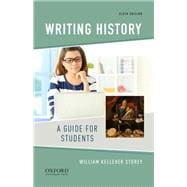
Writing History A Guide for Students
by Storey, William KelleherBuy New
Rent Textbook
Rent Digital
Downloadable: 180 Days
Downloadable: 365 Days
Downloadable: Lifetime Access
Used Textbook
We're Sorry
Sold Out
This item is being sold by an Individual Seller and will not ship from the Online Bookstore's warehouse. The Seller must confirm the order within two business days. If the Seller refuses to sell or fails to confirm within this time frame, then the order is cancelled.
Please be sure to read the Description offered by the Seller.
Summary
Using numerous examples from the works of cultural, political, and social historians, Writing History serves as an ideal text for any history course that asks students to conduct research. The sixth edition offers better guidance on how to begin a research paper and expanded sections on oral history and visual and material sources
Author Biography
William Kelleher Storey is Professor of History at Millsaps College. The author of several monographs and textbooks, he is currently writing a biography of Cecil Rhodes.
Table of Contents
Preface
Introduction
1. GETTING STARTED
1A Explore Your Interests
1B Find a Historical Motive
1C Focus Your Interests Early
1D Work with Bibliographies
1E Search Preselected Databases on the Internet
1F Use Reference Sources to Begin a Project
1G Conduct a General Search on the Internet
1H Scan the Search Results
1I Get a Quick First Impression
1J Critically Assess Sources on the Internet
1K Speak with a Librarian
1L Speak with Your Professor
1M Approach Your Topic from a Particular Angle
1N Browse for More Sources
1O Form a Hypothesis
1P Craft a Proposal
1Q Write an Annotated Bibliography
1R Talk to People About Your Topic
1S If You Have to Abandon a Topic, Do It Early
Flowchart Chapter 1: Constructing an Argument Based on Sources
2. INTERPRETING SOURCE MATERIALS
2A Distinguish Primary Sources from Secondary Works
2B Refine Your Hypothesis with Who, What, Why, Where, and When
2C Be Sensitive to Points of View in Your Sources
2D Select the Most Important Source Materials
2E Take Notes by Being Selective
Flowchart Chapter 2: Taking Notes
3. WRITING HISTORY FAITHFULLY
3A Collect and Report Your Sources Carefully
3B Incorporate the Ideas of Others with Care and Respect
3C Know the Difference Between Summaries and Paraphrases
3D Learn How and When to Quote
3E Use Ellipses and Brackets, But Do Justice to Your Sources
3F Learn How to Use Quotation Marks
3G Don't Plagiarize
3H Be Honest, But Don't Give Unnecessary Citations
3I Choose a Citation System That Suits Your Audience
Exercise: How to Cite
4. USING SOURCES TO MAKE INFERENCES
4A Be True to Recognized Facts
4B Transform Facts into Evidence
4C Check Your Facts
4D Check the Internal Consistency of Primary Sources
4E Check Primary Sources Against Each Other
4F Compare Primary Sources with Secondary Works
4G Conduct Interviews Systematically
4H Compare Sources to Make Inferences
4I Make Inferences About Visual and Material Sources
4J Move from Inferences to Arguments
4K Make Reasonable Inferences from Your Sources
4L Make Inferences That Are Warranted
4M Avoid Unwarranted Comparisons
4N Avoid Anachronistic Inferences
Flowchart Chapter 4: Understanding Sources
5. GET WRITING! GET ORGANIZED
5A Craft a Thesis Statement
5B Create a Draft Outline of an Analytical Essay
5C Create a Draft Outline of a Narrative Essay
5D Complete Your Outline
5E Start to Write a First Draft
5F Grab Your Reader's Attention, But Do It Gently
5G State Your Intellectual Interests Early
5H Review the Historical Literature
5I Build Your Essay with Good Paragraphs
5J Define Your Key Terms Early
5K Set an Appropriate Tone
5L Treat Other Writers with Consideration
5M Account for Counterarguments
5N Lead Your Readers to an Interesting Conclusion
Flowchart Chapter 5: Writing Your First Draft
6. NARRATIVE TECHNIQUES FOR HISTORIANS
6A Combine Chronology with Causation
6B Get a Sense of Change and Continuity
6C Select the Key Participants in Your Story
6D Find Your Own Voice as a Narrator
6E Choose Your Own Beginning and End
6F Write a Narrative with Well-Chosen Details
6G Write a Narrative to Support an Argument
Flowchart Chapter 6: Representing the Past
7. WRITING SENTENCES IN HISTORY
7A Choose Verbs That Are Precise
7B Make Passive Sentences Active
7C Write in the Past Tense
7D Avoid Split Infinitives If You Can
7E Put Verbs in Your Sentences
7F Put Your Ideas in an Intelligible Order
7G Begin a Sentence on Common Ground and Gradually Build a New Point
7H Place the Emphasis at the End
7I Construct Parallel Forms for Emphasis
7J Form the Possessive Correctly
7K Break the Rules If You Must
8. CHOOSING PRECISE WORDS
8A Be Concise
8B Write in Language That Your Audience Can Understand
8C Avoid Pretentious Language
8D Avoid Colloquial Language
8E Be Sensitive to the Politics of Diction
8F Be Sensitive to Gender-Specific Language
8G Avoid Euphemisms
8H Choose Figurative Language Carefully
8I Use Metaphors and Similes Judiciously
8J Use Color, But Avoid Clich?s
8K Use Foreign Words That Are Familiar to Your Audience
8L Check for These Common Diction Problems
9. REVISING AND EDITING
9A Get Some Perspective on Your Draft
9B Work with a Peer Editor
9C Revise Your Draft
9D Evaluate Your Own Arguments and Narratives
9E Evaluate Your Sentences and Word Choices
9F Proofread the Final Draft
9G Keep the Rules in Mind, But Enjoy Your Writing
Flowchart Chapter 9: Writing Your Final Draft?
Notes
Answers for Exercise: How to Cite
Index
An electronic version of this book is available through VitalSource.
This book is viewable on PC, Mac, iPhone, iPad, iPod Touch, and most smartphones.
By purchasing, you will be able to view this book online, as well as download it, for the chosen number of days.
A downloadable version of this book is available through the eCampus Reader or compatible Adobe readers.
Applications are available on iOS, Android, PC, Mac, and Windows Mobile platforms.
Please view the compatibility matrix prior to purchase.
